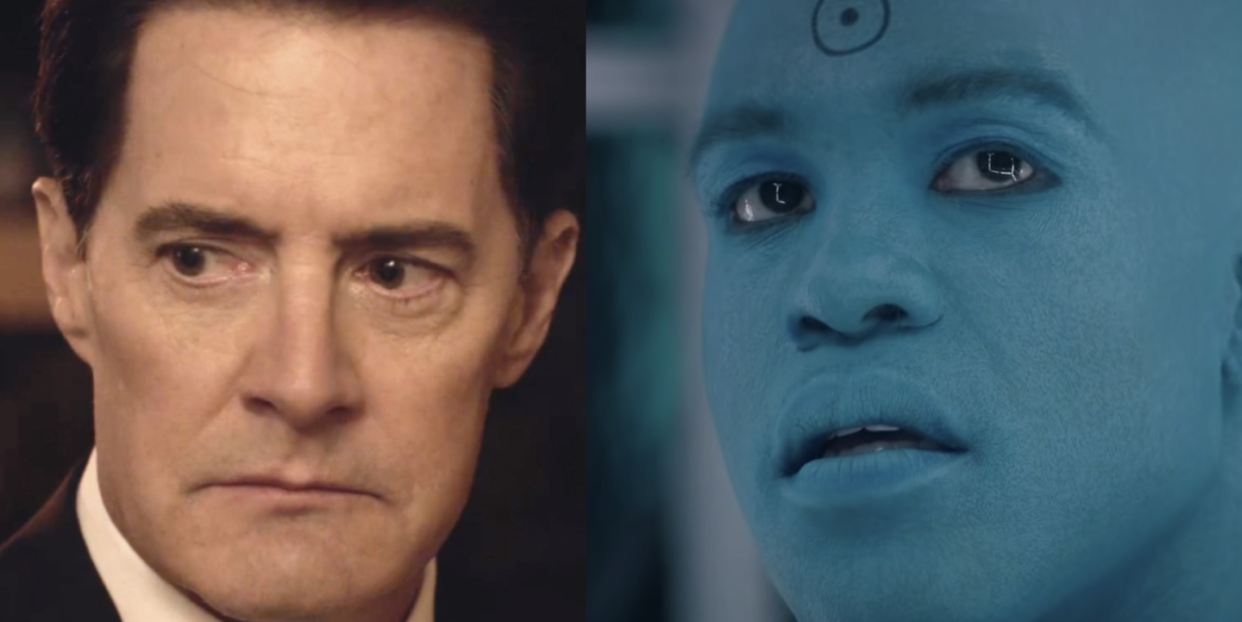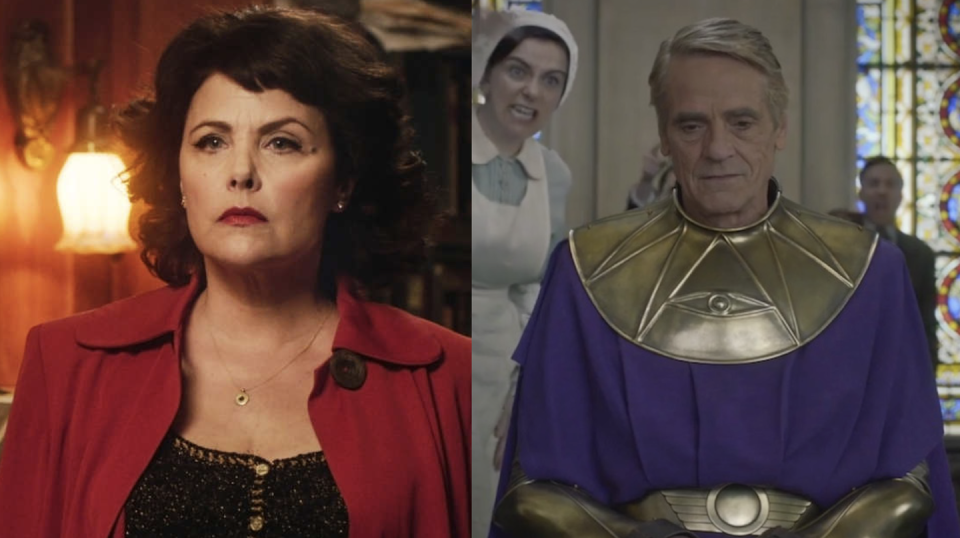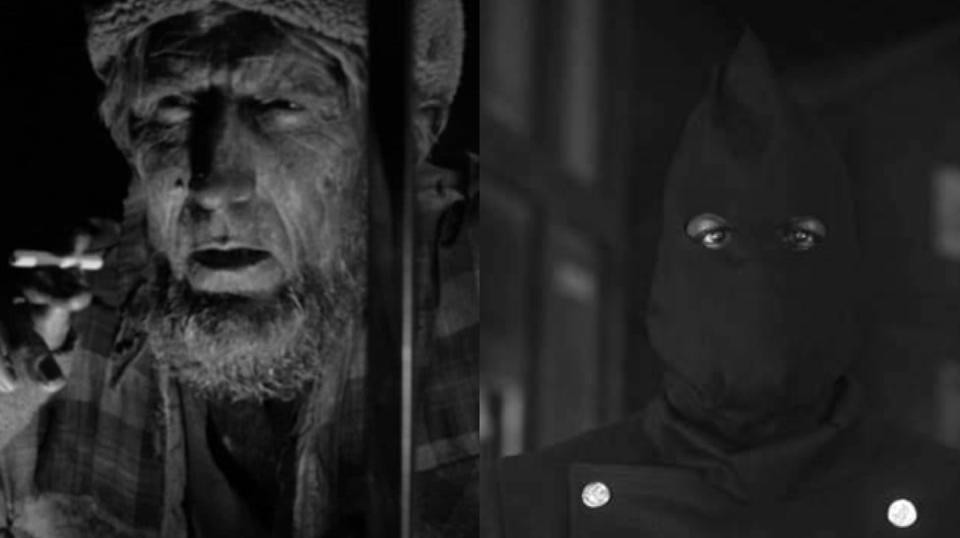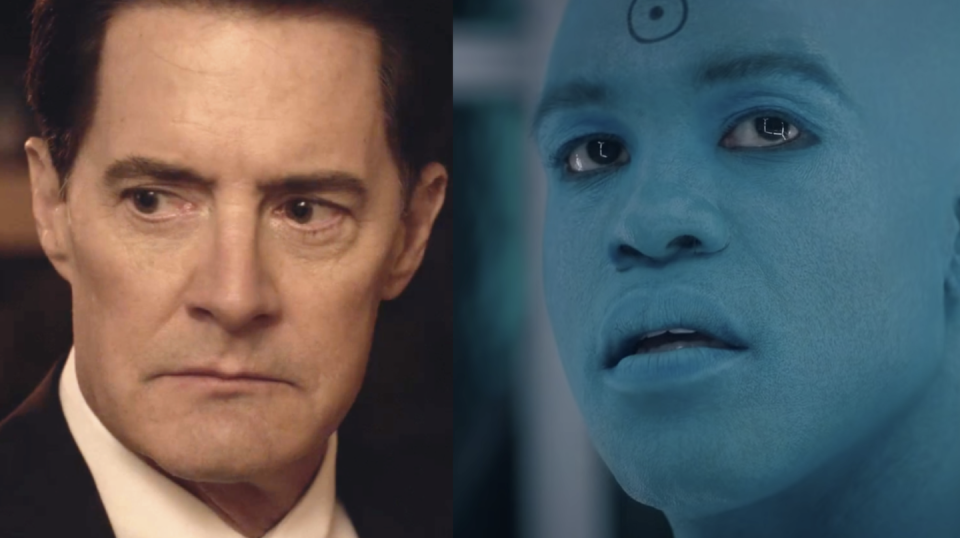There Are Astounding Connections Between HBO's 'Watchmen' and 'Twin Peaks: The Return'

You don’t have to watch Watchmen to know that Damon Lindelof is a huge Twin Peaks fan. The guy talks about his love of David Lynch all the time, and he appeared not once, but three times on Entertainment Weekly’s A Twin Peaks Podcast, which is co-hosted by Jeff Jensen. Lindelof would later enlist Jensen to help write his new HBO series. Jensen explains in the podcast that the Watchmen writer’s room was “under the influence of Twin Peaks.” During the summer of 2017, as The Return was airing, the group was planning their HBO series. And then, after Lynch’s show concluded in September 2017, the writer’s room for Watchmen began. So it makes sense that Watchmen feels so directly informed by The Return. Lynch was haunting the writing room from the very start.
Both Watchmen and The Return are obsessed with the expectations of the series that came before them. Lindelof's series is a "remix" (his word) of an already subversive story about the depravity of superheroes. Twin Peaks has always been about breaking down the formulaic bullshit of television soap operas and crime procedurals, and in The Return, Lynch turns the monotony of TV into his own experimental art installation. But the connections between Watchmen and The Return go deeper than just TV revisionism. From the very start of Lindelof's series in Tulsa, Oklahoma, to its final episodes that are adrift of time and space, Watchmen is in conversation with Twin Peaks. As we run down the parallels between the two subversive TV events–whether intentional or not–you'll notice that Lindelof's show could not stand without The Return as its foundation.

Las Vegas, Tulsa, and other new frontiers
What the fuck does Tulsa have to do with Watchmen? That's the first question we all asked when the show premiered back in October 2019. The comic books, of course, take place almost completely in New York City–the home of Moore and Gibbons's version of the Justice League–so it came as a huge surprise when HBO's new series set up shop in a city over a thousand miles away from Manhattan. Watchmen isn't just an adaptation of a 1990s comic book, though. From the outset, it's clear the director wanted to tell an original, modern story. And that meant fixing the representation in a virtually all-white comic series, first and foremost. By bringing Watchmen to Tulsa, Lindelof was able to tell a superhero story that we haven't seen before. He brought us to someplace new.
Lindelof can't take all the credit for the idea of introducing strange new territory to a well-known story. The original two seasons of Twin Peaks barely leave the titular Pacific Northwest town at all throughout their thirty episodes. But in The Return, Lynch spaces us all over the country. He's especially interested in Las Vegas, Nevada, the home of Dougie Jones–a guy completely new to the franchise who takes center stage in The Return. Las Vegas, Nevada is about as unlike Twin Peaks, Washington as you can get it. But that's what makes The Return so daring. Lynch has a reckless abandon for the expectations he set for himself twenty five years prior. The mysterious man from the original Twin Peaks is now played by a talking sapling tree. Some of the actors have been replaced with floating heads. Even the curtains in the Red Room jiggle a bit differently now. We don't want to see directors play it safe. Lynch never has. And Lindelof clearly took note by subverting all expectations of setting and the character's whose story he was telling.

Glass Boxes for interdimensional beings from the great beyond
The first episode of The Return is all about a big, weird, glass box. We don't quite know what the hell is going on inside that box–but we know whatever they're trying to trap inside it definitely isn't from this world. As it turns out, the evil Agent Cooper doppleganger, "Mr. C," was trying to keep track of his benevolent other-worldly counterpart. The box turned out to be some sort of portal for Twin Peaks's worlds between worlds. In Watchmen, we encounter much the same sort of device. The racist Seventh Kavalry is developing a machine that can contain a teleportation from Dr. Manhattan. Once inside, they try to use it to transfer his powers. Both boxes beam visions from beyond our physical world. Both have awful repercussions for humanity. Without getting too metatextual about it, it doesn't seem too far out to suggest that Lindelof, like Lynch, was making a statement on the dangers of the television boxes that we spend all hours of our days staring inside.

Purgatory and disassociation
Ozymandias was a main character of the Watchmen comic series. But for the majority of the HBO show, he is way off in some sort of purgatorial dream zone. It's the same for the fan-favorite rebellious teen from Twin Peaks, Audrey Horne. Lynch only served us tiny, confusing glimpses of Audrey, stuck with a stubborn partner who may also be her doctor, incapable of escaping his cramped office room. In the end, Lynch finally lets on that Audrey is institutionalized somewhere, stuck in some mental feedback loop in a coma state.
Adrian Veidt finds himself in feedback loop of his own in Watchmen–though his is a bit more involved than Audrey's. We discover that he's stuck on a moon of Jupiter, doomed to a false utopia of his own creation. Both characters are involved in horrific acts of violence in their respective stories. We find out in The Return that Audrey was a victim of abuse. And Ozymandias, of course, was on the other side of the violence, as he enacted a mass murder that took the lives of millions. Lynch has always had an unconventional approach to depicting the effects of cruelty on the human brain–it's part of why the dissociative state of the Red Room exists in the first place. The purgatorial spaces in both shows seem to give the viewer a sense of the brain-rattling terror that results from acts of human violence. Audrey and Adrian experienced pain too hard for the brain to comprehend, so both characters are both sent adrift. We as the audience may not understand what, physically, is going on, but the vibe of the whole thing rings true.

Returning to the black-and-white origins of evil
When "This Extraordinary Being," Episode 6 of Watchmen aired, us Twin Peaks fans were shocked, but not totally surprised–the series already had some big The Return connections, so it made sense that Lindelof would want to do his own atomic bomb thing. The episode bears an unmistakable resemblance to "Part 8" of Lynch's show, both visually and thematically. They even occur in their respective series at roughly the same place. In Watchmen, after Angela Abar swallows her grandfather's memory pills, she recedes several decades into the past. The world becomes black and white, and suddenly we're in another story entirely. But it's not a story that's insignificant to the main narrative of the series. It's the origins of superheroes–and a disturbing vignette about the evil that grew from this country's history of prejudice.
"Part 8" of The Return, too, is interested in history. But in Lynch's case, as always, it's a bit more indirect. The Return's eighth episode takes us inside an atomic bomb explosion, where we learn that the powers of interdimensional evil like BOB were born from mankind's own devastation of the Earth. It's up for interpretation, but in Lynch's black-and-white 1950s world, human cruelty seems to have some agency in supernatural forces of darkness. Fans of Watchmen know that the threat of atomic bombs and nuclear warfare is also vital to the Moore and Gibbons's original text. It's part of how Doctor Manhattan–the being responsible for the death of millions–was created in the first place. But, whereas atomic warfare is the origin of evil for The Return, Lindelof instead chose to point his lens toward the deeper terror of human prejudice in Watchmen. To tell a story about the violence and discrimination that continues to plague America to this day, Lindelof needed a wider canvas than just 2019. By peering far back in time, we're more capable of vividly understanding the depth of hatred that exists in our culture.

Time travelers
Both Twin Peaks and Watchmen are about characters who see time differently. Agent Cooper, trapped in a world between worlds, is experiencing time out of sync. Doctor Manhattan, on the other hand, experiences it all at once. And we don't get to see either of the characters, really, until the final two episodes of their respective shows. When they do return, there's something off about them. Their travels have made them different.
Agent Cooper in Twin Peaks gets back to reality after several copies of himself roam the world impersonating him. We waited 25 years to get the real Coop back–but he's not the same anymore. After abandoning his friends to try to fix the timeline once and for all, Kyle MacLachlan's character becomes a different man entirely. When he attempts to save Laura Palmer, he ends up spit out in an unfamiliar timeline, once again adrift of time and space, wondering, "What year is it?" Lynch knows the expectations for our hero are high. But, like everyone else, heroes are fallible. And fail, Cooper does.
Doctor Manhattan has always experienced time out of sync. But Lindelof's decision to withhold his return until the very end seems like a direct callback to The Return. It's another way of harnessing the audience's expectations to make a character's arrival burst through the television screen. Of course, like Cooper, Doctor Manhattan is incapable of saving the day. His egotistical perception of himself as a god among men deprives him of his own humanity. In fact, when Manhattan comes back, things only become worse–a great massacre, once again, is enacted because of Osterman's return. Doctor Manhattan was better off in his human form as Cal Abar. At least then he was a good father.

Human endings for human stories
In the end, Laura Palmer cannot be saved. Racism cannot be rooted out of society. Evil exists–but so does love and human empathy. The Return elegantly turned the lens away from the supernatural world and became introspective of human nature itself, in its ending episodes. By showing that Laura Palmer will be burdened with the grief of abuse across all timelines, Lynch shows that only the healing power of love can set things right. And in Lindelof's case, in keeping true to the Watchmen source text, the finale surmises that masks–and gods–cannot save us. There's no band-aid or special superpower that can rid the world of prejudice and hatred. By taking off our masks, people can build connections. Agent Cooper and Doctor Manhattan may see themselves as saviors. But both directors show that only humans can save themselves.
We may never see another season of television exactly like Twin Peaks: The Return. But after only two years, we are already seeing the influence it's made on television. From Atlanta to Russian Doll, series seem more willing than ever to break out of conventional storytelling traditions. It's made the landscape of television adventurous and full of creative risk-taking. Hopefully, if Watchmen comes back for a second season, Lindelof will continue to explore into the unknown.
You Might Also Like

